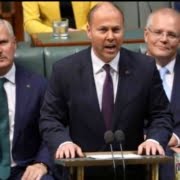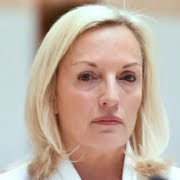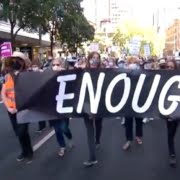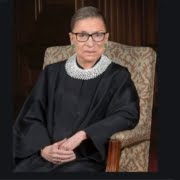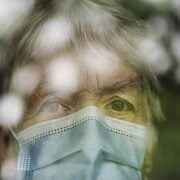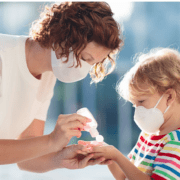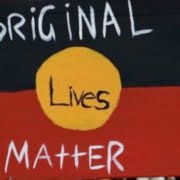Janine (age 61) is one of a large and growing number of older women who are homeless. Five years ago, she was made redundant from her position as an Office Manager in Perth. Despite great effort she has been unable to find a job and ultimately couldn’t afford to continue paying rent. Since beginning to live in her car 8 months ago, Janine has tried to find relatively safe places to park at night. As a result, she has accumulated parking fines which she simply can’t afford to pay … particularly as these have compounded, had administrative fees added and now total over $3,000. When Janine was pulled over by police for allegedly speeding, she was immediately arrested for these outstanding fines and sent to prison. She doesn’t know what’s happened to her car, which contains all her worldly possessions.
Imprisonment rates amongst Aboriginal and Torres Strait Islander women are particularly alarming. Nationally, First Nations women account for 2% of the Australian population, but represent 34% of women prisoners. First Nations women are being disproportionately sentenced to prison compared with non-indigenous women for the same crimes. In NSW, there has been a 49% increase in the number of First Nations women sentenced to prison since 2013 (compared with a 6% increase amongst other women). A recent study found that 87% of First Nations women had been in prison before – with homelessness being the main cause of women returning to prison within 9 months of release.
Selina (age 62) is an Aboriginal woman who moved to Melbourne when she left a violent relationship 3 years ago. Here, she quickly became homeless – mainly couch-surfing between family members. Selina drinks (to mask the many traumas she has experienced) in a place she feels safe – a park frequented by First Nations people. Every few days the police break up gatherings in the park, and Selina is invariably charged with offensive behaviour, swearing, public drunkenness and/or resisting arrest – her long criminal record is entirely made up of these and similar ‘offences’ committed over the past 3 years. She is usually imprisoned on remand because she doesn’t have a home address. Selina had never been to prison until moving to the city: she now regularly moves between homelessness and prison.
Imagine being put in prison without warning – even for ‘only’ 2-3 weeks. Imagine how this would affect every aspect of your life – your job, your rental property, custody of your children (or grandchildren), your friendships. Imagine that your only alleged offence was stealing food for child in your care, or evading a fare you couldn’t afford to meet a Centrelink requirement. Then, imagine that you hadn’t even been found guilty of this offence.
Across Australia, approximately 40% of women prisoners are on remand. In Victoria, for example, the number of women entering prison more than doubled between 2012 and 2018, and 9/10 were on remand. A further 20% are imprisoned for procedural offences, such as minor breaches of (often onerous) parole conditions or failure to appear in court – commonly due to poverty. Most women are imprisoned for minor, non-violent offences. These realities about the women’s prison population are reflected in the short time typically spent in prison – in Queensland, the median prison sentence across all prisoners is 3.9 months, and this is much shorter for women prisoners.
Mary (age 52) is an Aboriginal woman who has moved between the streets and prison since childhood. She was released on parole a couple of months ago, after serving a short term for street offences. Three weeks ago, she was cut off unemployment benefits for failing to meet job search requirements. This left Mary with no money – and unable to pay for public transport to report weekly to Probation and Parole. Whilst she usually walked the 5km, Mary was unwell on this particular day. She rang to request an alternate arrangement but was refused, and when she failed to report a warrant was issued for her arrest. Shortly after, she was picked up by the police and returned to prison for breach of parole.
The rise in the number of women prisoners not serving ‘substantive’ sentences is mainly due to failures of the state. It has run parallel with cuts to housing, health and welfare services, and increased funding to police and prisons. Most women are refused bail due to homelessness, or unmet mental health or substance abuse needs. With the vast majority of women prisoners (90% of First Nations women) having experienced domestic violence, often these needs were driven by DV. (Ironically, breach of a DV Order is now amongst the top 10 reasons for women’s imprisonment in Queensland – another example of law reform having unintended consequences.)
After surviving many years of abuse, Cheryl (age 55) finally grabbed a saucepan and wacked her violent partner over the head. When police arrived, they assumed she was the primary perpetrator and imposed a DVO on her. The order required that she not enter the house. As the primary carer of her 3 grandchildren, Cheryl felt she had little choice but to break the order to care for her family. Her partner was happy with this arrangement … until another argument broke out and he called the police. Cheryl was immediately arrested for breach of DVO and taken to prison.
More older women are going to prison
The number of older women prisoners in Australia has grown very significantly over the past 20 years.
There hasn’t been a detailed study of older Australian prisoners since 2011, and there has never been a study of older women prisoners. But, in our experience at Sisters Inside, the trends identified in 2011 are continuing and worsening. Our Health Support Program in Brisbane, for example, estimates that the number of women over 55 they are supporting has almost doubled over the past 3 years: 70% of the women they work with are now aged 55-64, and 80% are First Nations women.
Between 2000 and 2010, the number of 50+ women prisoners more than tripled – nearly twice the growth rate of male prisoners (and higher than the growth rate of younger women prisoners). From 2010-2014, there was a 140% increase in 65+ prisoners in NSW which reflected the national trend. By 2018 there were a total of 5,790 prisoners aged 50+ in Australia. Of these, 334 were women (with 27 being 65+). Whilst these numbers are relatively small, they represent a massive increase in the number of older women imprisoned over the past 20 years.
We don’t know how many of these women were Aboriginal or Torres Strait Islander. In 2010, the overall number of older First Nations prisoners was relatively lower due to their shorter life expectation. Only 7% of women prisoners were 50+ in 2010. However, it is reasonable to expect that First Nations women prisoners aged 40+ will face similar issues to non-First Nations prisoners aged 50+. Between 2000 and 2010, the fastest growing age group amongst First Nations women prisoners was aged 45-49.
We don’t know much about older women prisoners. It is unclear how many are serving short sentences, how many are first-time prisoners, and how many have aged inside prison whilst serving long sentences. We do know that their growth rate exceeds the growth in the number of older women in the general population.
It has been suggested that increases in the number of older prisoners in Australia is a result of a growing aged population, mandatory sentencing, tighter bail laws, improved forensic techniques, longer sentences for serious crimes and a reluctance to release some prisoners. Given the small number of women serving very long sentences, it would seem that the increase amongst women would likely be explained by poverty – older women being imprisoned on remand due to homelessness.
Rising poverty amongst older women increases their risk of imprisonment. As detailed in Augustine Zycher’s recent article Abandoning Old People on Ice Floes, about 1/3 of single women 55+ and over a million women 65+ are living in poverty. I am very concerned that the number of older women in prison will continue to increase exponentially.
Prison is a particularly terrible place for older women
Prison is no place for any woman, particularly older women.
The reality is that we, as a community, must stop criminalising and imprisoning women (and girls), particularly Aboriginal and Torres Strait Islander women.
Sisters Inside is increasingly seeing women prisoners with serious health needs – problems like chronic cardiac and respiratory illnesses; severe depression; and degenerative conditions.
Joan (age unknown) was observed wandering aimlessly around the prison by Sisters Inside workers. She had kept getting on public transport without paying for a ticket, and was eventually charged with fare evasion. Joan was remanded in custody because she became angry when pressured to provide family contact details and refused to provide a home address. Once in prison, Joan kept entering prohibited areas and was threatened with disciplinary charges by prison staff. It quickly became evident to our staff that Joan had dementia, and didn’t even understand that she was in prison. Once Sisters Inside found her family, we were able to ascertain that Joan had never previously been in trouble, and secure her release on bail to her family.
Several studies have suggested that the health age of Australian prisoners may be 10 years older than their chronological age. Many of the women we work with already entered prison with poorer health than women in the general community (and male prisoners).
Older women’s health deteriorates in prison. The standard of both medical and mental health care in prison is significantly lower than in the general community. Studies suggest that because older prisoners are typically more compliant than younger prisoners, their health can be completely overlooked in the prison system.
Maureen (age 63) had emphysema and other chronic health conditions. She served a 6 month sentence. When she finally got to see a doctor, he refused to prescribe the preventative inhaler she had been using prior to imprisonment, and her breathing became increasingly laboured. By the time Maureen was released from prison, her health had deteriorated to the point that she now requires oxygen with her at all times.
Prisons are designed for young, able-bodied prisoners. Prisons are ill-equipped to respond to common problems amongst older prisoners such as limited mobility, hearing or vision impairments, incontinence or frailty. Too often, older women prisoners are ‘doubly punished’ in an environment which is harsher for them than other prisoners, and can be dangerous.
And, being a minority within the prison population, older women (along with prisoners with disabilities) are vulnerable to violence, abuse, neglect or exploitation by both prison staff and other prisoners. Prior to imprisonment, some older women prisoners were being helped with tasks of daily living through NDIS. Professional personal carers are generally not available in prison, and older prisoners are forced to depend on others for assistance with showering, or getting into a bunk bed … or more vulnerable activities such as toileting.
Once released, older women’s difficulties can further escalate. Too often this leaves them struggling to meet parole conditions and puts them at risk of returning to prison. Most prisons offer limited pre-release planning, and post-release women can find themselves with inadequate health care, housing, possessions, transport assistance or disability support to survive on the outside.
That’s why Sisters Inside advocates for the individual and collective rights of older criminalised women.
Sisters Inside advocates for the human rights of criminalised women
Sisters Inside exists to undertake public advocacy and address the unmet human rights and needs of criminalised women and girls, and their children. Our primary goal is to keep as many women and children out of prison as possible.
Sisters Inside has taken a public leadership role on the human rights of women prisoners and other criminalised women in Australia for over 20 years. Over the past decade we have increasingly engaged in international campaigns to achieve justice for criminalised women and girls. Sisters Inside has formal consultative status at the United Nations, and much of our time at a management level is now spent working alongside like-minded organisations across many countries.
Our services are available to all women in the criminal legal system in Queensland. Sisters Inside workers are increasingly supporting older women, many of whom struggle to survive in the prison system. We are particularly conscious of the needs of older Aboriginal and Torres Strait Islander women prisoners, and employ First Nations Elders, managers and staff to ensure that we respond to women’s needs in a culturally appropriate way.
Our first priority is to prevent women and girls from going to prison at all! Our youth and women’s workers in the Brisbane police watch-house support women and girls to access lawyers and whatever they need to get bail: anything from housing, to a place in rehab, to a counsellor, to enrolment in school. We support women and girls in South East Queensland when they first appear in court, then support those who are granted bail to meet their bail conditions. In the future, we hope to be able to offer this service throughout Queensland.
Inside prisons, Sisters Inside offers violence-related counselling and support; help to maintain family relationships; and help accessing bail and parole in all women’s prisons in Queensland. We also receive some limited funding to help women and girl prisoners to plan for release.
On the outside, Sisters Inside offers a wide range of services throughout Queensland – health support, housing support, family reunification, parenting support, practical/financial help … and whatever else women need to get their lives together after the trauma of prison. We also support children and young people whose mums are in prison, or who are criminalised themselves, to access housing, education and employment, and address any issues that put them at risk of ending up in prison.
Imprisonment shouldn’t be a death sentence
A Queensland judge recently said “If an 85-year-old is given a five-year term, without being dramatic about it, it is likely to be a form of life sentence as opposed to the 20-year-old”.
There is great fear of COVID-19 virus reaching our overcrowded prisons. Here social distancing is impossible, soap is considered a luxury (which women must pay for themselves), many cells do not have running water and hand sanitiser is contraband (due to its alcohol content). Our women prisoners are left defenceless against the onslaught of the virus.
Many women prisoners (both old and young) have chronic health conditions. This places them at higher risk of a severe case of COVID-19. It is critical that women prisoners are released and suitably housed, before a few days on remand for unpaid fines, stealing food or fare evasion turns into a death sentence for someone’s mother, or grandmother, or sister, or daughter.
As a nation, we are paying approximately $300 per night to keep each woman in prison – to punish them for poverty. Imagine the inestimable harm that could be prevented to women (and their families) if we spent $2,100 per week on meeting each woman’s needs.
About the author
Debbie Kilroy has led Sisters Inside, an organisation which advocates for the human rights of criminalised women and their children, for almost 3 decades. Having spent 20 years moving in and out of adult and children’s prisons in Queensland, Debbie began Sisters Inside when she was finally released in 1992. Debbie is a qualified lawyer, social worker, gestalt therapist and forensic mental health practitioner.


